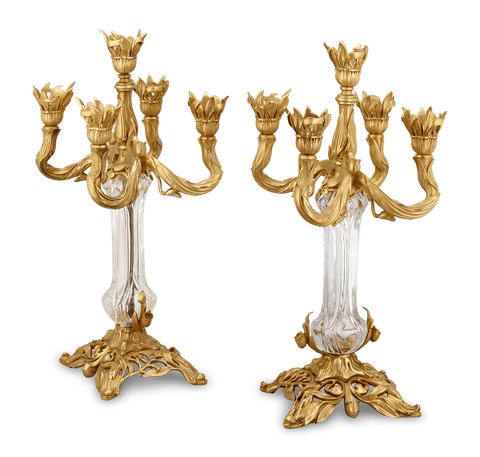Artists & Artisans
Baccarat
Established by the Royal Decree of Louis XV in 1765, Baccarat has consistently produced glass and crystal works that have revolutionized and dazzled the industry. From the beginning, the company received numerous royal commissions from French nobility and aristocrats across Europe, most notably Czar Nicolas of Russia, Louis XV, Louis XVI and Napoleon.
Situated in Baccarat, Meurthe-et-Moselle, France, the company owns two museums: the Musée Baccarat in Baccarat and the Musée Baccarat in Paris and remains a prominent arbiter of taste and sophistication.
Founding (1764-1816)
The closure of Rozières saltworks in 1760 led to excess wood available in Baccarat. The Bishop of Metz Monseigneur de Montmorency-Laval set up a glassworks there, aiming to boost the industry, and in 1764, King Louis XV granted the Bishop permission to establish the glassworks. Initially producing window panes, mirrors and stemware, it transitioned to crystal production in 1816, employing over 3,000 workers by this point.
1823-1870
Although still named "Verrerie" (glassworks), the factory began to specialize in crystal, utilizing the English technique pioneered at the Saint-Louis-lès-Bitche glassworks, which the company would come to perfect. Pierre-Antoine Godard-Desmarest, a former director of military supplies under the Empire, François-Marie-Augustin Lescuyer-Vespin, a landowner in Charleville, and Nicolas-Rémy Lolot, a trader in Charleville bought the company in 1822, combining it with the glassworks of Trélon in the Thiérache region of northern France which manufactured pane glass. The firm gained legal status as a limited company in 1824.Godard-Desmarest delegated the company's management to a young polytechnic engineer, Jean-Baptiste Toussaint. This strategic move led to the emergence of two family legacies: one overseeing the company's capital, while the other managing its operational affairs. Under the management of Toussaint, the company thrived, receiving its first royal commission from King Louis XVIII in 1823. Situated strategically in the Vosges foothills, Baccarat enjoyed a boom, supplying luxury glassware to royal families worldwide.
The arrival of François-Eugène de Fontenay in 1841 led to the production of colored glass and the development of multicolored crystal paperweights. Baccarat's watermarked glass products, featuring the signature "B", became popular domestically and internationally between 1846 and 1895.
The company earned its first gold medal at the 1855 World's Fair in Paris and registered its trademark in 1860. Expanding into luxury crystalware, Baccarat gained renown for its high-quality glass, chandeliers, vases and perfume bottles.
1870-1936
The Imperial Era concluded in 1870 after Napoléon III's defeat. Global influences, notably from Japan, shaped Baccarat's work during the period that followed. Baccarat experienced significant growth in Asia and gained renown among royal households. The company contributed to the Dolmabahçe Palace in Istanbul with the world's largest Bohemian crystal chandelier, weighing 4.5 tons, alongside an extensive array of additional objects crafted by Baccarat. Furthermore, two of the second-largest Baccarat chandeliers reside in the Jai Vilas Palace in Gwalior, India, each weighing 3 tons. Built in 1874 by Jayajirao Scindia, the Maharaja of Gwalior, the Jai Vilas Palace showcases these magnificent fixtures as a testament to Baccarat's craftsmanship.By 1891, nearly three-quarters of the town's population worked at the crystal glassworks or resided with its employees. Employment at the factory soared from 1,125 in 1855 to 2,223 in 1900, making it one of France's largest factories.
Towards the end of the 19th century, Baccarat established a warehouse, retail store and bronze workshop near Gare de l'Est in Paris, employing around 246 people by 1899. The building later served as the Baccarat Museum until 2003.
Baccarat's perfume bottles became one of their most popular products, with production exceeding 4,000 bottles per day by 1907. In 1936, the company began marking all its works via acid or sandblasting.
1936-Present Day
Following the challenges of wartime occupation, Baccarat embarked on a path of global expansion, establishing a presence in the United States in 1948. Presently, the company remains renowned as a premier producer of crystal and glass worldwide. Its collaborations with distinguished fashion designers, luxury distillers and prominent artists reflect its ongoing commitment to excellence on the global stage. Today, it takes their glassworkers 15 years to master all the skills needed to produce Baccarat’s Crystals. Baccarat is still regarded as the finest glassmaker in Europe and is known as both the Crystal of Kings and the King of Crystal.Quick Facts:
-
The company earned its first gold medal at the 1855 World's Fair in Paris.
-
Baccarat wins the highest award, the Grand Prix, at the 1867 World’s Fair in Paris.
-
A retrospective was held in 1964 at the Louvre Museum to celebrate the 200th anniversary of the crystal works.
-
In 1994, Baccarat created a gigantic crystal chandelier with 230 lights for its 230th anniversary.
Artists & Artisans
Baccarat
Established by the Royal Decree of Louis XV in 1765, Baccarat has consistently produced glass and crystal works that have revolutionized and dazzled the industry. From the beginning, the company received numerous royal commissions from French nobility and aristocrats across Europe, most notably Czar Nicolas of Russia, Louis XV, Louis XVI and Napoleon.
Situated in Baccarat, Meurthe-et-Moselle, France, the company owns two museums: the Musée Baccarat in Baccarat and the Musée Baccarat in Paris and remains a prominent arbiter of taste and sophistication.
Founding (1764-1816)
The closure of Rozières saltworks in 1760 led to excess wood available in Baccarat. The Bishop of Metz Monseigneur de Montmorency-Laval set up a glassworks there, aiming to boost the industry, and in 1764, King Louis XV granted the Bishop permission to establish the glassworks. Initially producing window panes, mirrors and stemware, it transitioned to crystal production in 1816, employing over 3,000 workers by this point.
1823-1870
Although still named "Verrerie" (glassworks), the factory began to specialize in crystal, utilizing the English technique pioneered at the Saint-Louis-lès-Bitche glassworks, which the company would come to perfect. Pierre-Antoine Godard-Desmarest, a former director of military supplies under the Empire, François-Marie-Augustin Lescuyer-Vespin, a landowner in Charleville, and Nicolas-Rémy Lolot, a trader in Charleville bought the company in 1822, combining it with the glassworks of Trélon in the Thiérache region of northern France which manufactured pane glass. The firm gained legal status as a limited company in 1824.Godard-Desmarest delegated the company's management to a young polytechnic engineer, Jean-Baptiste Toussaint. This strategic move led to the emergence of two family legacies: one overseeing the company's capital, while the other managing its operational affairs. Under the management of Toussaint, the company thrived, receiving its first royal commission from King Louis XVIII in 1823. Situated strategically in the Vosges foothills, Baccarat enjoyed a boom, supplying luxury glassware to royal families worldwide.
The arrival of François-Eugène de Fontenay in 1841 led to the production of colored glass and the development of multicolored crystal paperweights. Baccarat's watermarked glass products, featuring the signature "B", became popular domestically and internationally between 1846 and 1895.
The company earned its first gold medal at the 1855 World's Fair in Paris and registered its trademark in 1860. Expanding into luxury crystalware, Baccarat gained renown for its high-quality glass, chandeliers, vases and perfume bottles.
1870-1936
The Imperial Era concluded in 1870 after Napoléon III's defeat. Global influences, notably from Japan, shaped Baccarat's work during the period that followed. Baccarat experienced significant growth in Asia and gained renown among royal households. The company contributed to the Dolmabahçe Palace in Istanbul with the world's largest Bohemian crystal chandelier, weighing 4.5 tons, alongside an extensive array of additional objects crafted by Baccarat. Furthermore, two of the second-largest Baccarat chandeliers reside in the Jai Vilas Palace in Gwalior, India, each weighing 3 tons. Built in 1874 by Jayajirao Scindia, the Maharaja of Gwalior, the Jai Vilas Palace showcases these magnificent fixtures as a testament to Baccarat's craftsmanship.By 1891, nearly three-quarters of the town's population worked at the crystal glassworks or resided with its employees. Employment at the factory soared from 1,125 in 1855 to 2,223 in 1900, making it one of France's largest factories.
Towards the end of the 19th century, Baccarat established a warehouse, retail store and bronze workshop near Gare de l'Est in Paris, employing around 246 people by 1899. The building later served as the Baccarat Museum until 2003.
Baccarat's perfume bottles became one of their most popular products, with production exceeding 4,000 bottles per day by 1907. In 1936, the company began marking all its works via acid or sandblasting.
1936-Present Day
Following the challenges of wartime occupation, Baccarat embarked on a path of global expansion, establishing a presence in the United States in 1948. Presently, the company remains renowned as a premier producer of crystal and glass worldwide. Its collaborations with distinguished fashion designers, luxury distillers and prominent artists reflect its ongoing commitment to excellence on the global stage. Today, it takes their glassworkers 15 years to master all the skills needed to produce Baccarat’s Crystals. Baccarat is still regarded as the finest glassmaker in Europe and is known as both the Crystal of Kings and the King of Crystal.Quick Facts:
-
The company earned its first gold medal at the 1855 World's Fair in Paris.
-
Baccarat wins the highest award, the Grand Prix, at the 1867 World’s Fair in Paris.
-
A retrospective was held in 1964 at the Louvre Museum to celebrate the 200th anniversary of the crystal works.
-
In 1994, Baccarat created a gigantic crystal chandelier with 230 lights for its 230th anniversary.





